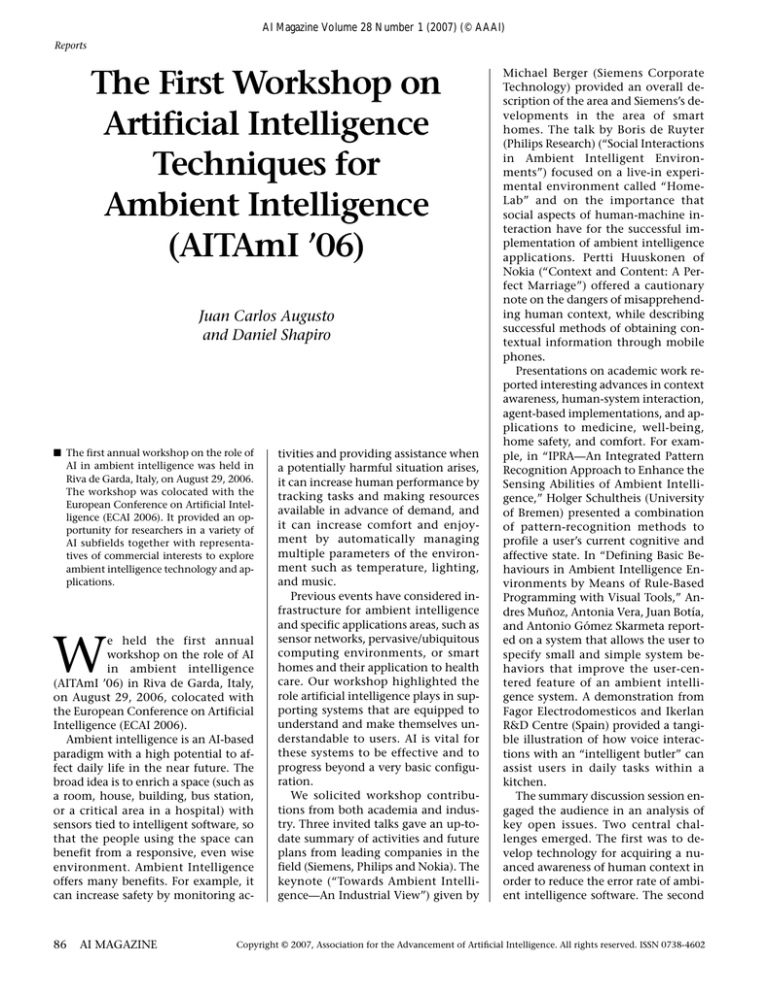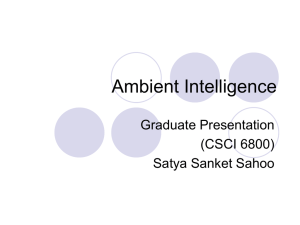
AI Magazine Volume 28 Number 1 (2007) (© AAAI)
Reports
The First Workshop on
Artificial Intelligence
Techniques for
Ambient Intelligence
(AITAmI ’06)
Juan Carlos Augusto
and Daniel Shapiro
■ The first annual workshop on the role of
AI in ambient intelligence was held in
Riva de Garda, Italy, on August 29, 2006.
The workshop was colocated with the
European Conference on Artificial Intelligence (ECAI 2006). It provided an opportunity for researchers in a variety of
AI subfields together with representatives of commercial interests to explore
ambient intelligence technology and applications.
W
e held the first annual
workshop on the role of AI
in ambient intelligence
(AITAmI ’06) in Riva de Garda, Italy,
on August 29, 2006, colocated with
the European Conference on Artificial
Intelligence (ECAI 2006).
Ambient intelligence is an AI-based
paradigm with a high potential to affect daily life in the near future. The
broad idea is to enrich a space (such as
a room, house, building, bus station,
or a critical area in a hospital) with
sensors tied to intelligent software, so
that the people using the space can
benefit from a responsive, even wise
environment. Ambient Intelligence
offers many benefits. For example, it
can increase safety by monitoring ac-
86
AI MAGAZINE
tivities and providing assistance when
a potentially harmful situation arises,
it can increase human performance by
tracking tasks and making resources
available in advance of demand, and
it can increase comfort and enjoyment by automatically managing
multiple parameters of the environment such as temperature, lighting,
and music.
Previous events have considered infrastructure for ambient intelligence
and specific applications areas, such as
sensor networks, pervasive/ubiquitous
computing environments, or smart
homes and their application to health
care. Our workshop highlighted the
role artificial intelligence plays in supporting systems that are equipped to
understand and make themselves understandable to users. AI is vital for
these systems to be effective and to
progress beyond a very basic configuration.
We solicited workshop contributions from both academia and industry. Three invited talks gave an up-todate summary of activities and future
plans from leading companies in the
field (Siemens, Philips and Nokia). The
keynote (“Towards Ambient Intelligence—An Industrial View”) given by
Michael Berger (Siemens Corporate
Technology) provided an overall description of the area and Siemens’s developments in the area of smart
homes. The talk by Boris de Ruyter
(Philips Research) (“Social Interactions
in Ambient Intelligent Environments”) focused on a live-in experimental environment called “HomeLab” and on the importance that
social aspects of human-machine interaction have for the successful implementation of ambient intelligence
applications. Pertti Huuskonen of
Nokia (“Context and Content: A Perfect Marriage”) offered a cautionary
note on the dangers of misapprehending human context, while describing
successful methods of obtaining contextual information through mobile
phones.
Presentations on academic work reported interesting advances in context
awareness, human-system interaction,
agent-based implementations, and applications to medicine, well-being,
home safety, and comfort. For example, in “IPRA—An Integrated Pattern
Recognition Approach to Enhance the
Sensing Abilities of Ambient Intelligence,” Holger Schultheis (University
of Bremen) presented a combination
of pattern-recognition methods to
profile a user’s current cognitive and
affective state. In “Defining Basic Behaviours in Ambient Intelligence Environments by Means of Rule-Based
Programming with Visual Tools,” Andres Muñoz, Antonia Vera, Juan Botía,
and Antonio Gómez Skarmeta reported on a system that allows the user to
specify small and simple system behaviors that improve the user-centered feature of an ambient intelligence system. A demonstration from
Fagor Electrodomesticos and Ikerlan
R&D Centre (Spain) provided a tangible illustration of how voice interactions with an “intelligent butler” can
assist users in daily tasks within a
kitchen.
The summary discussion session engaged the audience in an analysis of
key open issues. Two central challenges emerged. The first was to develop technology for acquiring a nuanced awareness of human context in
order to reduce the error rate of ambient intelligence software. The second
Copyright © 2007, Association for the Advancement of Artificial Intelligence. All rights reserved. ISSN 0738-4602
Reports
Riva de Garda (right) and Lake Garda (top),
in the Province of Trento, Italy.
was to explicitly address a mediation role, as ambient intelligence systems will commonly be in the position of providing multiple users with access to shared resources.
More details on the event can be obtained from the workshop website.1 The second event in this series (AITAmI’07)
was colocated with IJCAI 07 in Hyderabad, India.
Note
1. www.infj.ulst.ac.uk/~jcaug/aitami06.htm.
Juan Carlos Augusto (BSc. 1992, Ph.D. 1998 in
computer science) is a lecturer at the School of
Computing and Mathematics, University of Ulster at Jordanstown. His current research focus is
on ambient intelligence with emphasis on context awareness and the use of formal methods for
the development of ambient intelligence systems. More details can be obtained from www.infj.ulst.ac.uk/~jcaug/.
Dan Shapiro (Ph.D., Stanford 2001) is the president of Applied Reactivity, Inc., a contract research firm focused on scaling up learning technologies, and technical manager of the Defense
Advanced Research Projects Agency’s (DARPA)
Transfer Learning project at the Institute for the
Study of Learning and Expertise (ISLE). He can be
reached at dgs at stanford.edu.
SPRING 2007
87



